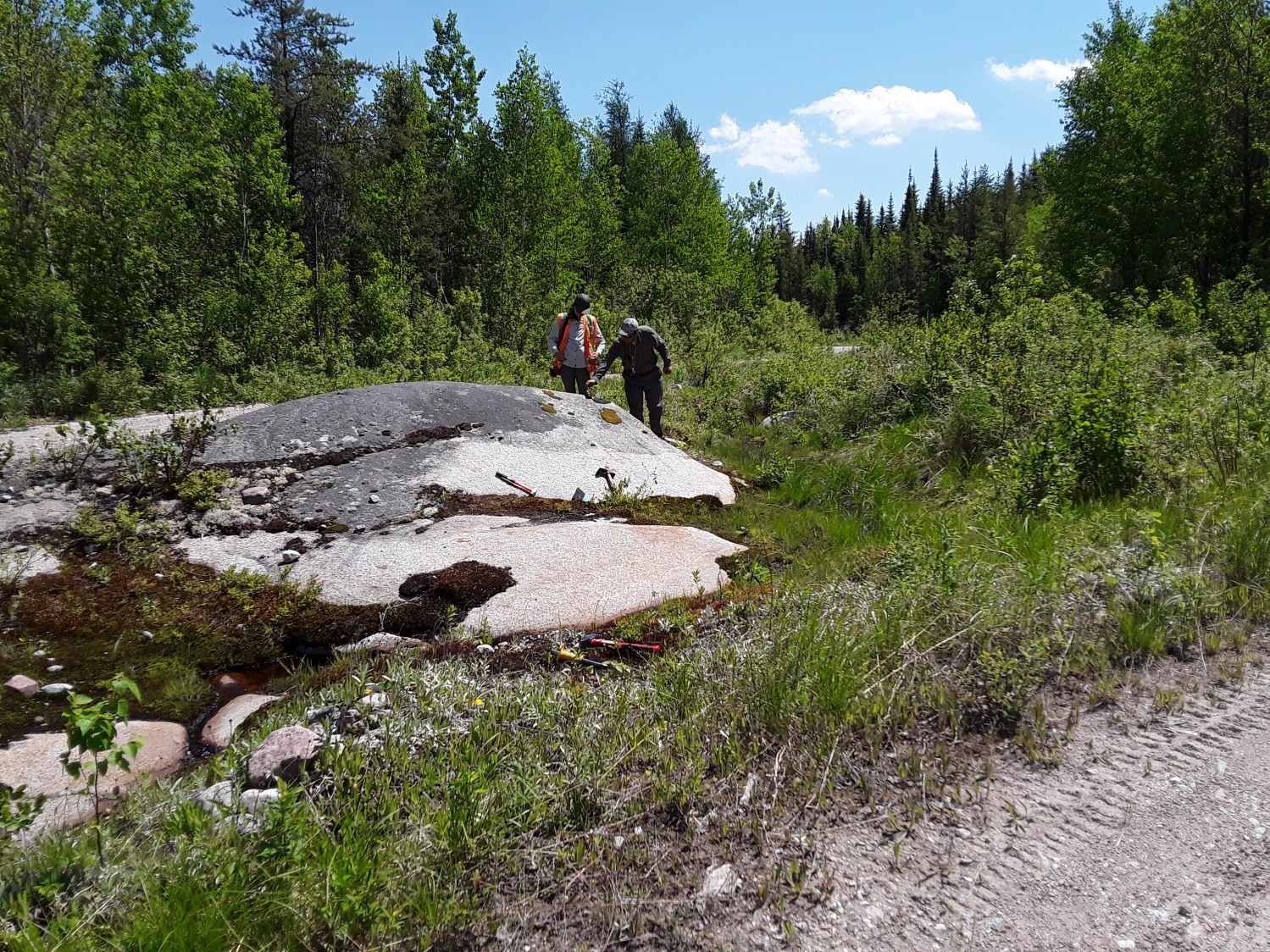
DISCLAIMER: This English version is translated from the original French. In case of any discrepancy, the French version shall prevail.
| Author(s): | El Bourki and Moukhsil, 2021 |
| Age: | Mesoproterozoic |
| Stratotype: | Reference outcrop 2021-ME-1018 |
| Type area: | Areas east of Rats Lake and east of Écluse Lake (NTS sheet 32H01) |
| Geological province: | Grenville Province |
| Geological subdivision: | Allochton |
| Lithology: | Felsic, intermediate and mafic plutonic rocks |
| Category: | Lithodemic |
| Rank: | Lithodeme |
| Status: | Formal |
| Use: | Active |
None
Background
The Écluse Batholith was defined during mapping work by El Bourki and Moukhsil (2021) in areas north of Dolbeau-Mistassini (NTS sheet 32H01), Girardville and Lac Blondelas (sheet 32H07) in the Saguenay–Lac-Saint-Jean region. The name refers to Écluse Lake (sheet 32H01).
Description
The Écluse Batholith is a polyphase intrusion consisting of two subunits (mPecl1 and mPecl2) that can be mapped at the 1:50,000 scale. The typical outcrops are located east of Rats Lake and east of Écluse Lake. Its delineation is made possible using the aeromagnetic map of sheet 32H01 (Intissar and Benahmed, 2015), where the intrusion stands out for its high magnetic susceptibility. The batholith is composed of alkali feldspar granite, quartz syenite, alkali feldspar syenite, gabbronorite, and lesser proportions of leuconorite and pyroxenite. Some fine-grained gabbro dykes cut the batholith.
Écluse Batholith 1 (mPecl1): alkali feldspar granite, quartz syenite, alkali feldspar syenite, gabbronorite and leuconorite
The alkali feldspar granite is magnetic, generally pink-grey in altered and fresh surfaces, locally pink-brown in alteration patina, medium-grained, porphyroid and foliated. The granite is deformed at the edge of the batholith, but is marked by magmatic to submagmatic foliation in the rest of the intrusion. It contains variable proportions of quartz, slightly chloritized biotite, traces of green hornblende, orthopyroxene (<1%) and magnetite. The potassium feldspar is mainly perthitic and locally contains myrmekite. Biotite and green hornblende are mostly found as clusters of grains. Epidote, apatite and zircon are present as accessory minerals.
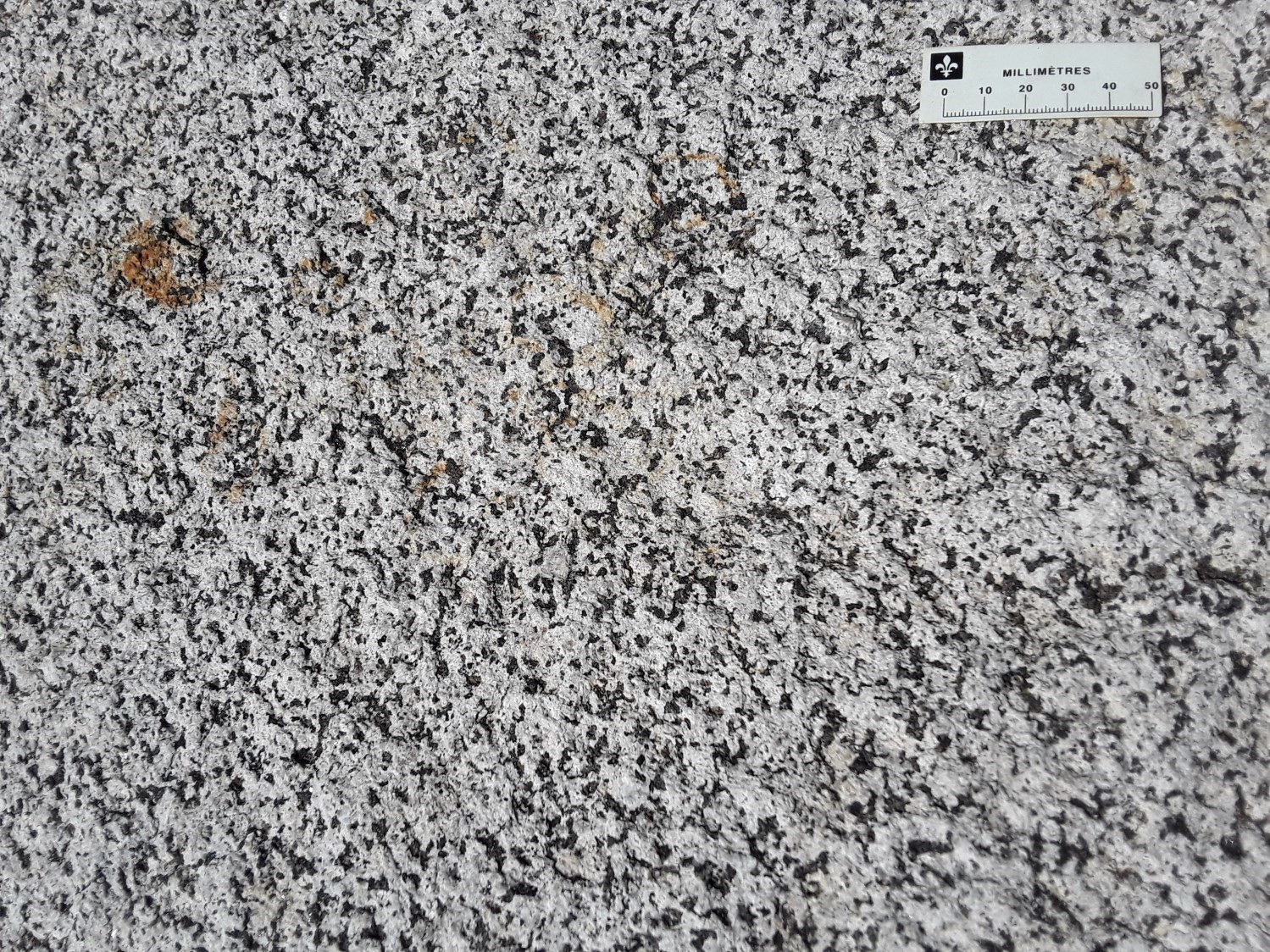
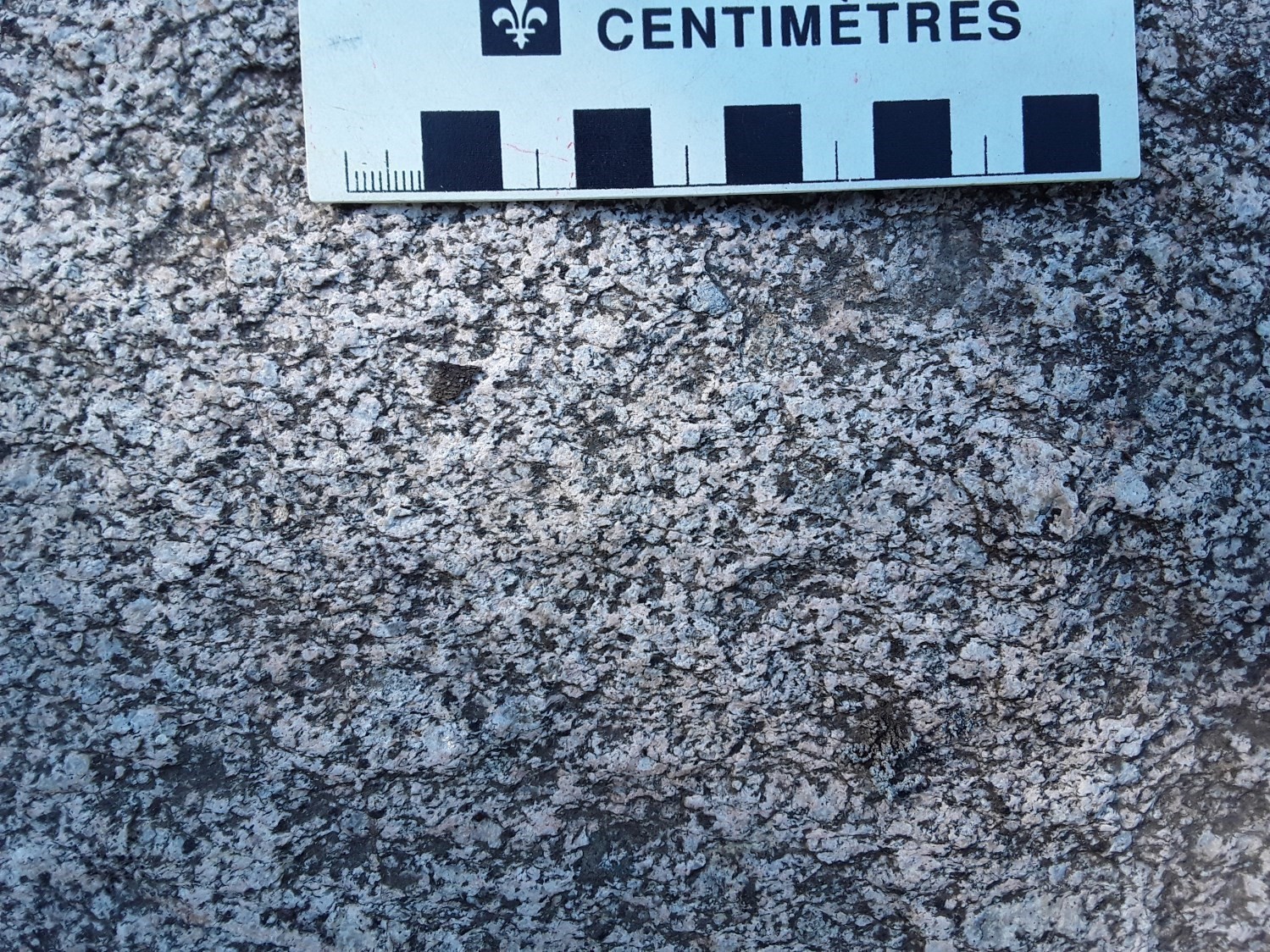 The quartz syenite is highly magnetic, white to pink-grey in alteration patina and greyish to pink-white in fresh surface. The rock is medium to coarse grained, porphyroid with potassium feldspar phenocrysts (10-15% of the rock, e.g. outcrop 2021-AM-135) and foliated. In the field, the rock locally shows 20-35% of ferromagnesian minerals in centimetric clusters whose orientation indicates the magmatic foliation of the intrusion. Microscopically, the main minerals in this rock are perthitic potassium feldspar, plagioclase (albite), magnetite, clinopyroxene, biotite, green hornblende and magnetite. Accessory minerals are apatite, allanite and zircon. The quartz syenite contains a few enclaves (<1%) of centimetric size and dioritic composition.
The quartz syenite is highly magnetic, white to pink-grey in alteration patina and greyish to pink-white in fresh surface. The rock is medium to coarse grained, porphyroid with potassium feldspar phenocrysts (10-15% of the rock, e.g. outcrop 2021-AM-135) and foliated. In the field, the rock locally shows 20-35% of ferromagnesian minerals in centimetric clusters whose orientation indicates the magmatic foliation of the intrusion. Microscopically, the main minerals in this rock are perthitic potassium feldspar, plagioclase (albite), magnetite, clinopyroxene, biotite, green hornblende and magnetite. Accessory minerals are apatite, allanite and zircon. The quartz syenite contains a few enclaves (<1%) of centimetric size and dioritic composition.
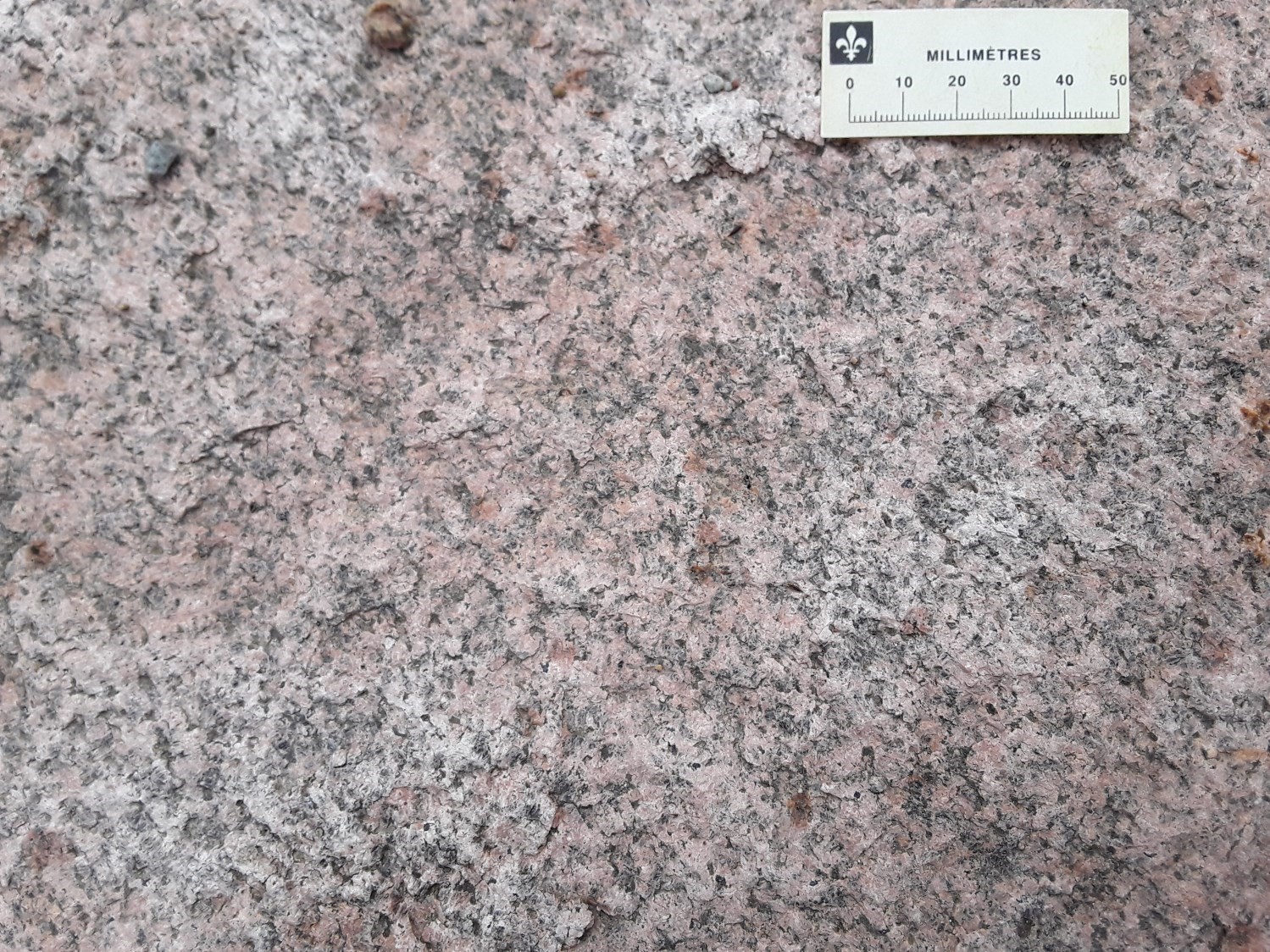 Alkali feldspar syenite (e.g., outcrop 2021-AM-143) is pink-grey in alteration patina and pink to locally purplish in fresh surface. The rock is medium to coarse grained, magnetic and shows a low degree of deformation. The rock contains crystals of quartz, perthitic potassium feldspar, orthopyroxene, biotite, green hornblende and magnetite. Under the microscope, ~8% of the potassium feldspar is completely sericitized and some biotite grains show an onset of chloritization. Some microcrystals of secondary muscovite are in contact with these crystals. Hornblende and traces of orthopyroxene are found in clusters, which also contain some allanite crystals.
Alkali feldspar syenite (e.g., outcrop 2021-AM-143) is pink-grey in alteration patina and pink to locally purplish in fresh surface. The rock is medium to coarse grained, magnetic and shows a low degree of deformation. The rock contains crystals of quartz, perthitic potassium feldspar, orthopyroxene, biotite, green hornblende and magnetite. Under the microscope, ~8% of the potassium feldspar is completely sericitized and some biotite grains show an onset of chloritization. Some microcrystals of secondary muscovite are in contact with these crystals. Hornblende and traces of orthopyroxene are found in clusters, which also contain some allanite crystals.
Leuconorite outcrops are not very abundant; they have been mapped mainly at the batholith edge and are associated with syenite and alkali feldspar granite. Leuconorite is greyish-white in alteration patina, greyish in fresh break, medium to coarse grained, locally porphyroclastic and generally foliated. It consists of plagioclase, orthopyroxene, magnetite, hornblende and traces of clinopyroxene, quartz and potassium feldspar. Gabbronorite is mapped only at the contact between the two subunits and is associated with pyroxenite enclaves rusty to greenish in alteration patina (<35 cm thick). Gabbronorite enclaves are observed in the quartz syenite. These are rust-green to black in altered surface, granoblastic, of medium grain size and centimetric thickness. The gabbronorite consists of pyroxene, plagioclase and biotite.
Écluse Batholith 2 (mPecl2): gabbronorite with Fe-Ti ± P oxides (magnetite, apatite, ilmenite) and pyroxenite with sulphides (pyrite, chalcopyrite and pyrrhotite)
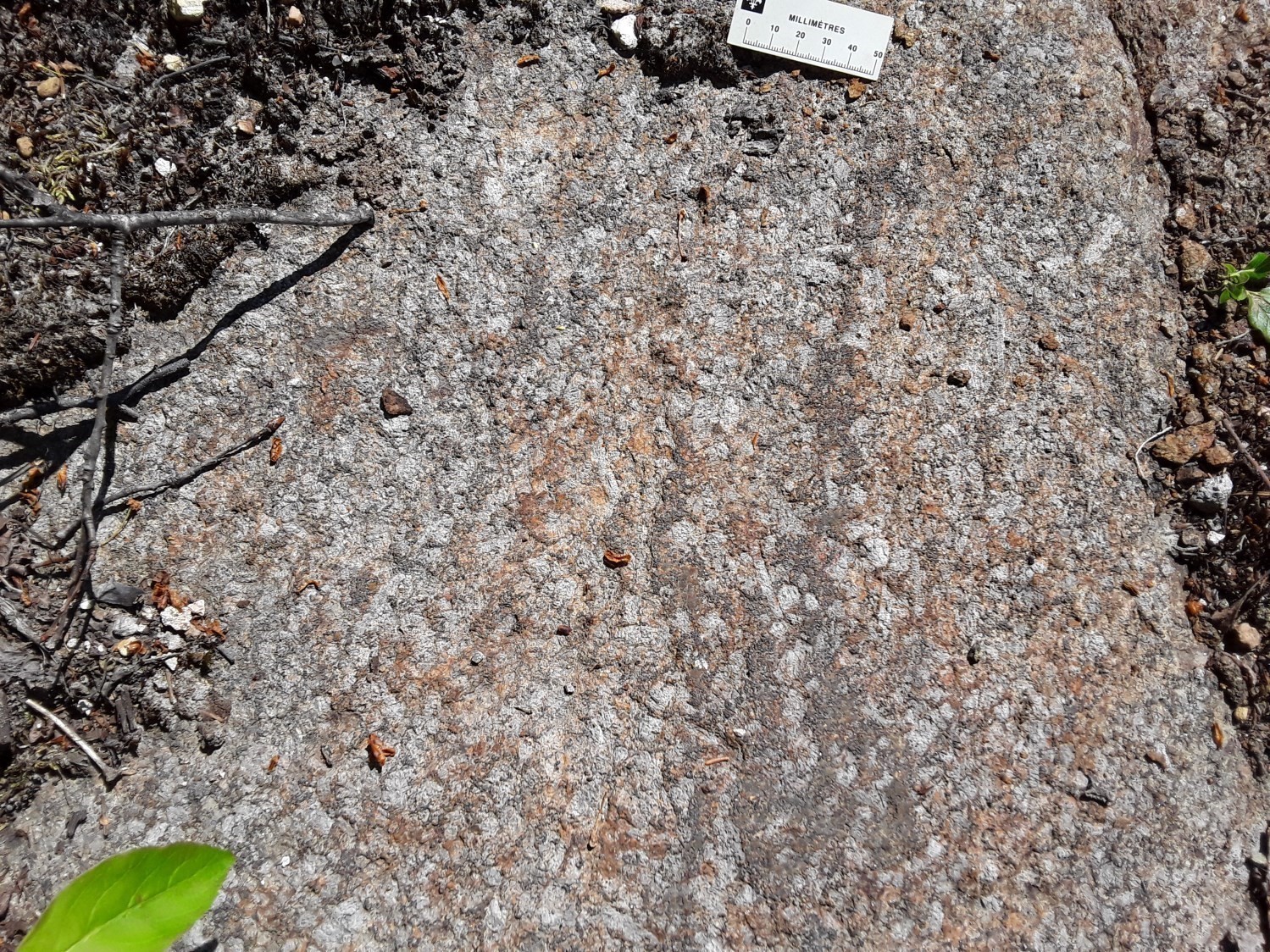
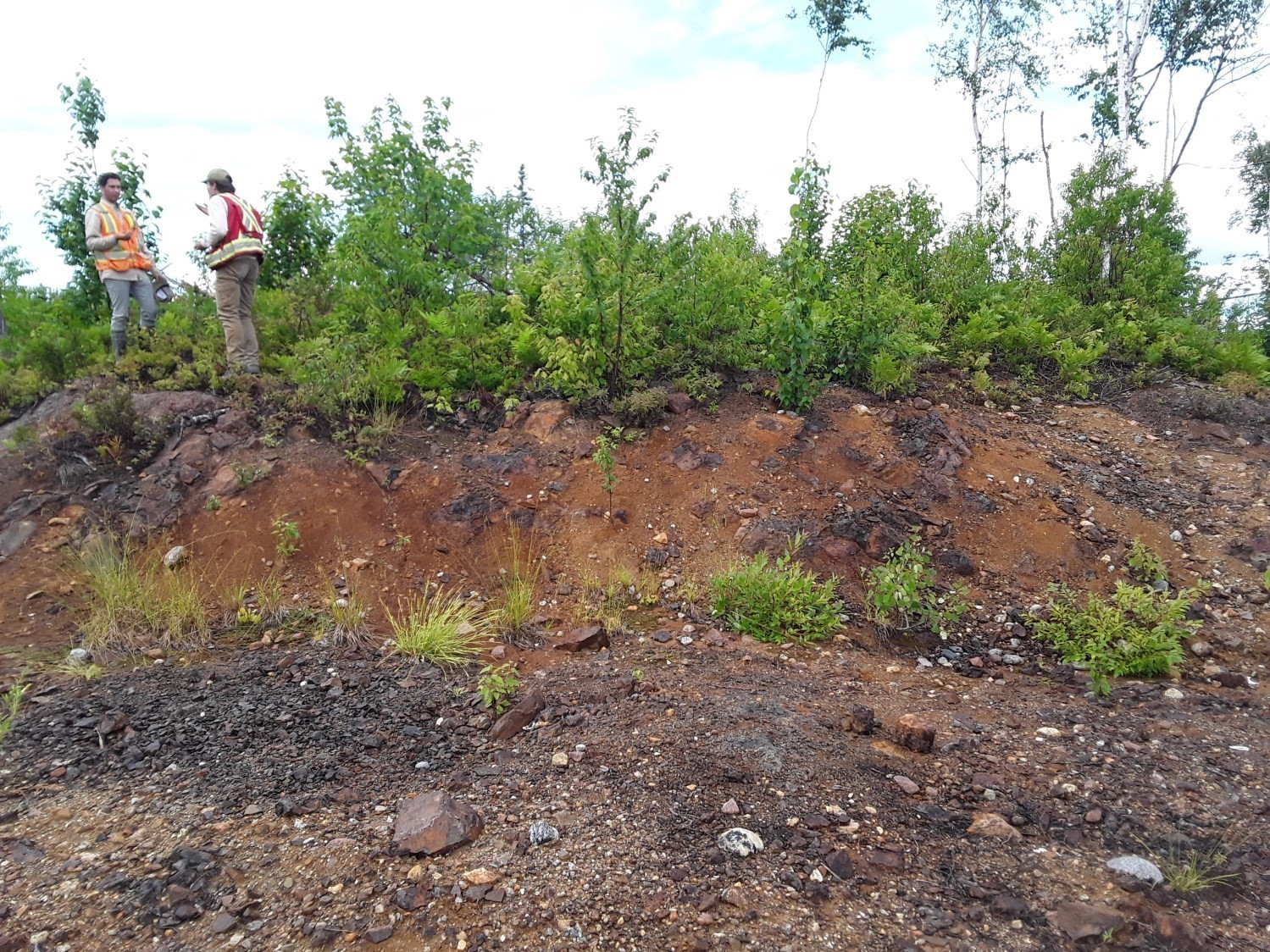 Gabbronorite is grey-brown, rusty to blackish in alteration patina, greyish in fresh surface, medium to porphyroid in plagioclase phenocrysts. The latter exceed, in places, 3.5 cm in length and can constitute up to 8% of the rock. It contains iron and titanium oxides as well as apatite (e.g. outcrop 2021-ME-1016). Fe-Ti oxides are disseminated to semi-massive (<45% of the rock) and the host gabbronorite has a compositional layering of dark (orthopyroxene, magnetite and hemo-ilmenite) and grey levels (mainly plagioclase; e.g. outcrop 2021-ME-1017). This gabbronorite can be considered as an OAGN (Oxides Apatite Gabbronorite; Owens and Dymek, 1992). It consists of plagioclase, orthopyroxene, clinopyroxene, magnetite, ilmenite, hemo-ilmenite (exsolved in magnetite), apatite and traces of sulphides (pyrite, pyrrhotite). A prospective zone for Fe-Ti-P mineralization has been identified in this unit (Murky Zone). Other gabbronorites in this unit, which are rusty in alteration patina and fresh surface, may contain up to 4% sulphides disseminated in the rock (pyrite, pyrrhotite, chalcopyrite, pentlandite). These outcrops are rust-coloured (e.g. outcrop 2021-AM-140) and also contain orthopyroxene, clinopyroxene, plagioclase, magnetite and ilmenite. The gabbronorite is cut by a fine-grained gabbro dyke (diabase). The latter is grey in alteration patina, black in fresh surface, very fine to aphanitic in grain size, undeformed, and contains magnetite and clinopyroxene.
Gabbronorite is grey-brown, rusty to blackish in alteration patina, greyish in fresh surface, medium to porphyroid in plagioclase phenocrysts. The latter exceed, in places, 3.5 cm in length and can constitute up to 8% of the rock. It contains iron and titanium oxides as well as apatite (e.g. outcrop 2021-ME-1016). Fe-Ti oxides are disseminated to semi-massive (<45% of the rock) and the host gabbronorite has a compositional layering of dark (orthopyroxene, magnetite and hemo-ilmenite) and grey levels (mainly plagioclase; e.g. outcrop 2021-ME-1017). This gabbronorite can be considered as an OAGN (Oxides Apatite Gabbronorite; Owens and Dymek, 1992). It consists of plagioclase, orthopyroxene, clinopyroxene, magnetite, ilmenite, hemo-ilmenite (exsolved in magnetite), apatite and traces of sulphides (pyrite, pyrrhotite). A prospective zone for Fe-Ti-P mineralization has been identified in this unit (Murky Zone). Other gabbronorites in this unit, which are rusty in alteration patina and fresh surface, may contain up to 4% sulphides disseminated in the rock (pyrite, pyrrhotite, chalcopyrite, pentlandite). These outcrops are rust-coloured (e.g. outcrop 2021-AM-140) and also contain orthopyroxene, clinopyroxene, plagioclase, magnetite and ilmenite. The gabbronorite is cut by a fine-grained gabbro dyke (diabase). The latter is grey in alteration patina, black in fresh surface, very fine to aphanitic in grain size, undeformed, and contains magnetite and clinopyroxene.
Thickness and distribution
The Écluse Batholith has a more or less rounded shape, with an N-S axis slightly longer than its E-W diameter, and ends in a peduncle. The intrusion is present in sheet 32H01 and occupies an area of ~45.5 km².
Dating
None.
Stratigraphic Relationship(s)
The Écluse Batholith is intrusive in the Lac-Saint-Jean Anorthositic Suite. Leuconorite and anorthosite enclaves are thus mapped in the border of both subunits. In turn, all phases of the batholith are generally cut by granite and granitic pegmatite dykes.
Paleontology
Does not apply.
References
Publications available through SIGÉOM Examine
El BOURKI, M., MOUKHSIL, A., 2021. Géologie de la région de Dolbeau-Blondelas, Province de Grenville, région du Saguenay–Lac-Saint-Jean, Québec, Canada. MERN; BG 2022-02, 1 plan.
INTISSAR, R., BENAHMED, S., 2015. LEVÉ MAGNÉTIQUE AÉROPORTÉ DANS LE SECTEUR OUEST DU LAC-ST-JEAN, PROVINCE DE GRENVILLE. MERN, GOLDAK AIRBORNE SURVEYS; DP 2015-06, 7 pages and 2 plans.
Other publications
OWENS, P.E., DYMEK, R.F., 1992. Fe-Ti-P rich rocks and massif anorthosite: problems of interpretation illustrated from the Labrieville and St-Urban plutons, Québec. Canadian Mineralogist; volume 30, pages 163-190. rruff.info/doclib/cm/vol30/CM30_163.pdf
Suggested Citation
Ministère de l’Énergie et des Ressources naturelles (MERN). Écluse Batholith. Quebec Stratigraphic Lexicon. https://gq.mines.gouv.qc.ca/lexique-stratigraphique/province-de-grenville/batholite-de-ecluse_en [accessed on Day Month Year].
Contributors
|
First publication |
Abdelali Moukhsil, P.Geo., Ph.D. abdelali.moukhsil@mern.gouv.qc.ca; Mhamed El Bourki, GIT, M.Sc. mhamed.elbourki@mern.gouv.qc.ca (redaction) Mehdi A. Guemache, P.Geo., Ph.D. (coordination); Fabien Solgadi, P. Geo., Ph.D. (critical review); Simon Auclair, P.Geo., M.Sc. (editing); Catherine Tremblay (English version). |

